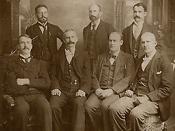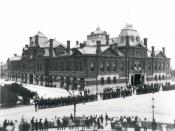Strikes throughout time have not had many changes. The disputes which were the cause of the strike usually start with the management of the corporation. Then the workers become disgruntled and ask for more benefits or a substitution for their lost wages. When the management refuses these terms the workers form a union. The union leaders will then go to the management and offer the terms of their co-workers. If the management again refuses these terms, the union will call a meeting. In this meeting the members of the union will review their options. This is when the union will move for a strike. If this movement passes in the union meeting everyone who is part of this union will strike and usually all work in their particular factory will halt.
In the case on the Pullman Boycott of 1894 the management over a period of nine months had reduced their workers wages by 25%.
The workers then formed a union which soon merged with the American Railway Union. This merger happened in April of 1894. (Warne, intro. vi) On May 10, 1894 the union voted to strike against Pullman Cars. Once the strike was declared Pullman fired the six hundred employees who did not join the strike. Pullman kept its shops closed until august 2. (Illinois State Museum)
"To bring pressure on Pullman, the union asked trainmen to refuse to run trains on which Pullman sleeping cars were attached. The union told the railroads that their trains could operate without the Pullman cars, but the railroads insisted that they had contracts with the Pullman Company requiring them to haul the sleeping cars. The result was an impasse, with railroad workers in and around Chicago refusing to operate passenger trains. The conflict was deep and bitter, and it...


